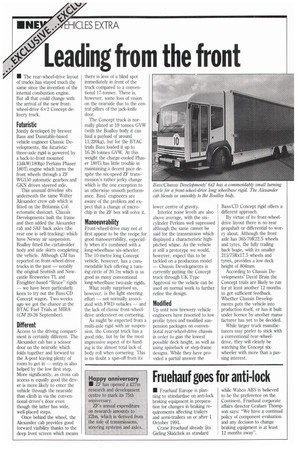Leading from the front
Page 12

If you've noticed an error in this article please click here to report it so we can fix it.
• The rear-wheel-drive layout of trucks has stayed much the same since the invention of the internal combustion engine. But all that could change with the arrival of the new frontwheel-drive 6x2 Concept delivery truck.
Futuristic
Jointly developed by brewer Bass and Dunstable-based vehicle engineer Chassic Developments, the futuristic three-axle rigid is powered by a back-to-front mounted 134kW(180hp) Perkins Phaser 180Ti engine which turns the front wheels through a ZF WG150 automatic gearbox and GKN driven steered axle.
This unusual driveline sits underneath the same Walter Alexander crew cab which is fitted on the Britannia Colectomatic dustcart. Chassis Developments built the frame and then added the Alexander cab and SAF back axles (the rear one is self-tracking) which have Neway air suspension. BoaHoy fitted the curtainsider body and side skirts completing the vehicle. Although CM has reported on front-wheel-drive trucks in the past — notably the original Scottish and Newcastle Breweries TL and Freighter-based "Bruce" rigids — we have been particularly keen to try out the Bass/CD Concept wagon. Two weeks ago we got the chance at the BTAC Fuel Trials at MIRA (CM 20-26 September).
Different
Access to the driving compartment is certainly different. The Alexander cab has a scissor door on the nearside which folds together and forward to the A-post leaving plenty of room to get in — entry is also helped by the low first step. More significantly, as cross cab access is equally good the driver is more likely to enter the vehicle through the nearside than climb in via the conventional driver's door even though the latter has wide, well-placed steps.
Once behind the wheel, the Alexander cab provides good forward visibility thanks to the deep front screen which means there is less of a blind spot immediately in front of the truck compared to a conventional 17-tonner. There is, however, some loss of vision on the nearside due to the central pillars of the jack-knife door.
The Concept truck is normally plated at 19 tonnes GVW (with the Boalloy body it can haul a payload of around 11,220kg), but for the BTAC trials Bass loaded it up to 16.26 tonnes GVW. At this weight the charge-cooled Pliaser 180Ti has little trouble in maintaining a decent pace despite the six-speed ZF transmission's rather jerky change which is the one exception to an otherwise smooth performance. Bass' engineers are aware of the problem and expect that a change of microchip in the ZF box will solve it.
Manoeuvrability
Front-wheel-drive may not at first appear to be the recipe for good manoeuvrability, especially when it's combined with a long-wheelbase six-wheeler. The 10-metre long Concept vehicle, however, has a commendable lock offering a turning circle of 20.7m which is as good as many conventional long-wheelbase two-axle rigids.
What really surprised us, however, is the light steering effort — not normally associated with FWD vehicles — and the lack of classic front-wheeldrive understeer on cornering.
As might be expected from a multi-axle rigid with air suspension, the Concept truck has a good ride, but by far the most impressive aspect of its handing is the almost total lack of body roll when cornering. This is no doubt a spin-off from its lower centre of gravity.
Interior noise levels are also above average, with the sixcylinder Perkins well supressed although the same cannot be said for the transmission which displayed a characteristic highpitched whine. As the vehicle is still a prototype we would, however, expect this to be tackled on a production model — Chassis Developments is currently putting the Concept truck through UK Type Approval so the vehicle can be used on normal work to further refine the design.
Modified
Up until now brewery vehicle engineers have resorted to low profile tyres and modified suspension packages on conventional rear-wheel-drive chassis in order to gain the lowest possible deck height, as well as using spineback or step-frame designs. While they have provided a partial answer the Bass/CD Concept rigid offers a different approach.
By virtue of its front-wheeldrive layout there is no rear propshaft or differential to worry about. Although the front axle has 365/70R22.5 wheels and tyres, the fully trailing back bogie, with its smaller 215/75Rx17.5 wheels and tyres, provides a low deck height of 804mm.
According to Chassis Developments' David Brain the Concept trials are likely to run for at least another 12 months to get sufficient feedback. Whether Chassis Developments puts the vehicle into production itself, or has it built under licence by another manufacturer has yet to be decided.
While larger truck manufacturers may prefer to stick with a conventional rear-wheeldrive, they will clearly be watching the Concept sixwheeler with more than a passing interest.
































































































